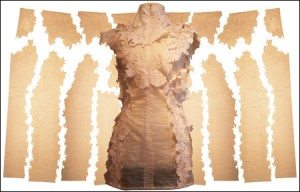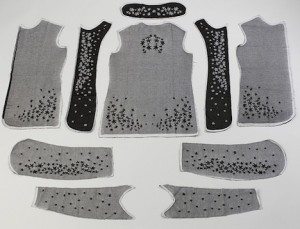
By Jessica Borges, LuxEco Living Editorial Assistant
Fashion design is an art, and just like other art forms such as writing, cooking, and painting, you need to scrap the first drafts and unruly pieces before producing your masterpiece. But with these scraps come a never-ending contribution to landfills and further pollution to our environment. This awareness has fueled designers in the fashion industry to attempt “zero waste fashion.”
The ambitious concept aims to create clothing patterns without leaving behind a single unused scrap. Considering that roughly 15 to 20 percent of fabric used to produce clothing ends up in the trash, it’s no wonder today’s money-tight and eco-conscious world is ready to make changes. Apparel industry professionals say that scrap waste is so prolific – generating millions of tons of garbage sent to landfills each year – because it is cheaper for them to dump scraps rather than recycle them.
 Bravo’s TV series “Project Runway” has stepped up to make zero waste fashion mainstream by challenging their designers to create outfits based on this movement. Though in its infantile stage in the United States, zero waste fashion is nothing new to many international designers such as Timo Rissanen, Holly McQuillan, Mark Liu and Julian Roberts. Finnish designer Rissanen will attempt to bring this eco-conscious school of thought to the U.S. this fall, along with Scott Mackinlay Hahn, founder of organic fashion label Loomstate. The duo will be at Parsons the New School for Design in New York teaching one of the world’s first courses focused on design and sustainability with zero-waste fashion at the core. The biggest obstacle for students may be to achieve this goal and still maintain style. “If it doesn’t look good,” Mackinlay Hahn told The New York Times, “it’s not going to sell.”
Bravo’s TV series “Project Runway” has stepped up to make zero waste fashion mainstream by challenging their designers to create outfits based on this movement. Though in its infantile stage in the United States, zero waste fashion is nothing new to many international designers such as Timo Rissanen, Holly McQuillan, Mark Liu and Julian Roberts. Finnish designer Rissanen will attempt to bring this eco-conscious school of thought to the U.S. this fall, along with Scott Mackinlay Hahn, founder of organic fashion label Loomstate. The duo will be at Parsons the New School for Design in New York teaching one of the world’s first courses focused on design and sustainability with zero-waste fashion at the core. The biggest obstacle for students may be to achieve this goal and still maintain style. “If it doesn’t look good,” Mackinlay Hahn told The New York Times, “it’s not going to sell.”
Designers have come up with two ways to eliminate waste:
1. To create a garment pattern “jigsaw cut” that fits together like a puzzle (with gussets, pockets, collars and trims) with no wasted space in between.
2. To avoid cutting the fabric completely; instead draping, tucking, layering and sewing it over a mannequin.
While these techniques are backed by good intentions, persuading large manufacturers to renovate existing infrastructures to accommodate the green movement is another hurdle. In the end there may be less fabric waste generated, but the steep costs of re-engineering a supply line to produce new fabric sizes are difficult for many companies to overlook. The shift to sustainable fashion is a challenging pursuit, particularly in an industry where excess is considered luxurious. But with leading designers toying with new ways to create desirable garments that embody style and sustainability, perhaps there is hope for the green trend to stick.













I receive a problem subscribing to your RSS Feed… It states feed is live, nevertheless I never get updates in my feed reader… Any Thoughts?
I’ve turn out to be examining some topics and really and receive your text. I’m simply organising my very own site and only wish i always might observe as well and supply the reader hence significantly info.
I have been reading Trying on Zero Waste Fashion | LuxEco Living for a while, but I finally got around to posting. Thanks for all of the information, you have created a great resource here.
Vielen Dank für dieses Blog-es ist toll! Ich mag diese Art von Menschen, die Wissen mit anderen zu teilen.